Fengling Li
A Survey on fMRI-based Brain Decoding for Reconstructing Multimodal Stimuli
Mar 20, 2025
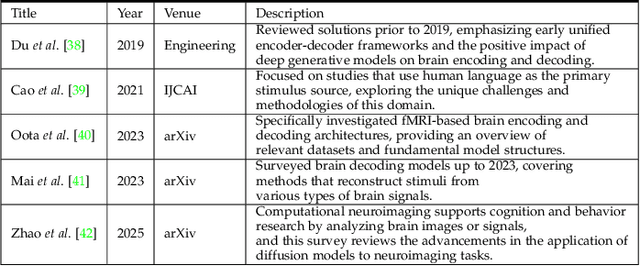
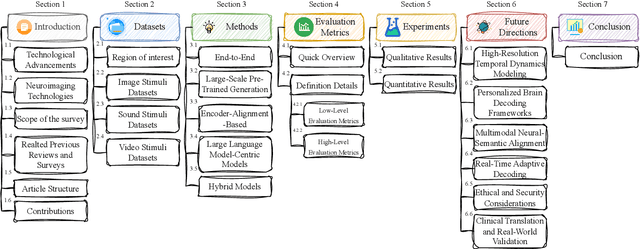
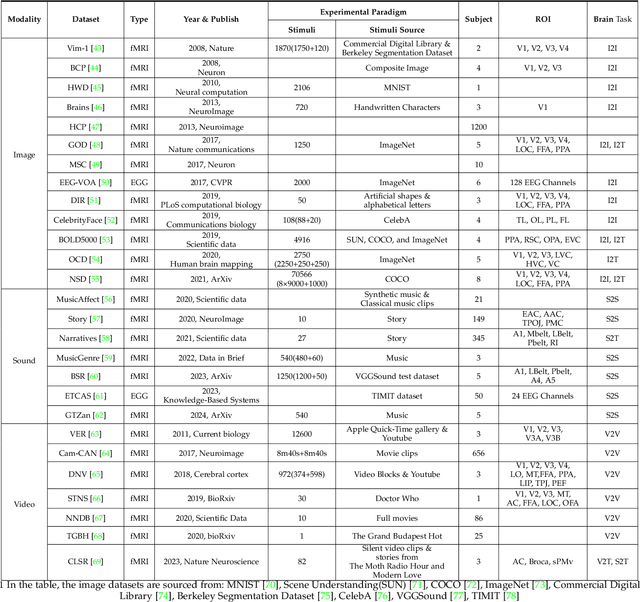
Abstract:In daily life, we encounter diverse external stimuli, such as images, sounds, and videos. As research in multimodal stimuli and neuroscience advances, fMRI-based brain decoding has become a key tool for understanding brain perception and its complex cognitive processes. Decoding brain signals to reconstruct stimuli not only reveals intricate neural mechanisms but also drives progress in AI, disease treatment, and brain-computer interfaces. Recent advancements in neuroimaging and image generation models have significantly improved fMRI-based decoding. While fMRI offers high spatial resolution for precise brain activity mapping, its low temporal resolution and signal noise pose challenges. Meanwhile, techniques like GANs, VAEs, and Diffusion Models have enhanced reconstructed image quality, and multimodal pre-trained models have boosted cross-modal decoding tasks. This survey systematically reviews recent progress in fMRI-based brain decoding, focusing on stimulus reconstruction from passive brain signals. It summarizes datasets, relevant brain regions, and categorizes existing methods by model structure. Additionally, it evaluates model performance and discusses their effectiveness. Finally, it identifies key challenges and proposes future research directions, offering valuable insights for the field. For more information and resources related to this survey, visit https://github.com/LpyNow/BrainDecodingImage.
Split to Merge: Unifying Separated Modalities for Unsupervised Domain Adaptation
Mar 11, 2024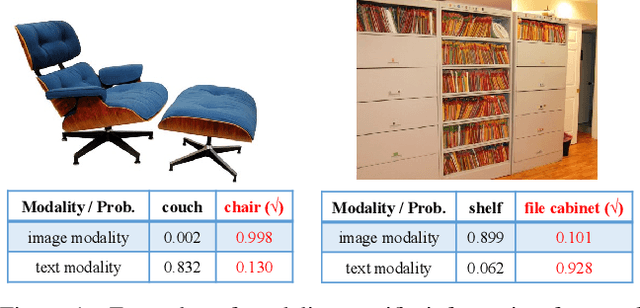
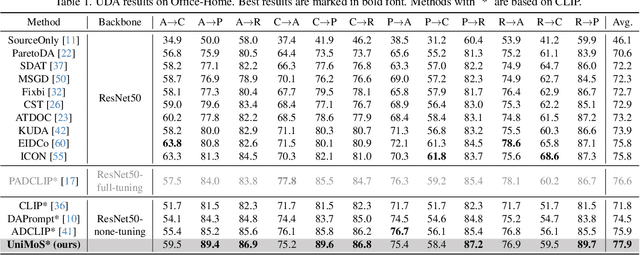
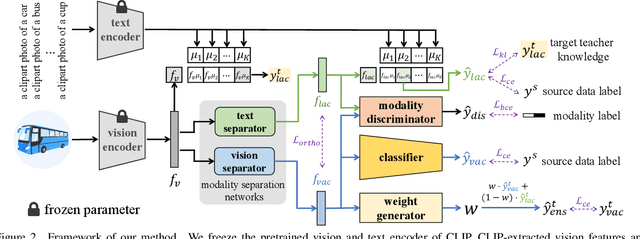

Abstract:Large vision-language models (VLMs) like CLIP have demonstrated good zero-shot learning performance in the unsupervised domain adaptation task. Yet, most transfer approaches for VLMs focus on either the language or visual branches, overlooking the nuanced interplay between both modalities. In this work, we introduce a Unified Modality Separation (UniMoS) framework for unsupervised domain adaptation. Leveraging insights from modality gap studies, we craft a nimble modality separation network that distinctly disentangles CLIP's features into language-associated and vision-associated components. Our proposed Modality-Ensemble Training (MET) method fosters the exchange of modality-agnostic information while maintaining modality-specific nuances. We align features across domains using a modality discriminator. Comprehensive evaluations on three benchmarks reveal our approach sets a new state-of-the-art with minimal computational costs. Code: https://github.com/TL-UESTC/UniMoS
Agile Multi-Source-Free Domain Adaptation
Mar 08, 2024



Abstract:Efficiently utilizing rich knowledge in pretrained models has become a critical topic in the era of large models. This work focuses on adaptively utilizing knowledge from multiple source-pretrained models to an unlabeled target domain without accessing the source data. Despite being a practically useful setting, existing methods require extensive parameter tuning over each source model, which is computationally expensive when facing abundant source domains or larger source models. To address this challenge, we propose a novel approach which is free of the parameter tuning over source backbones. Our technical contribution lies in the Bi-level ATtention ENsemble (Bi-ATEN) module, which learns both intra-domain weights and inter-domain ensemble weights to achieve a fine balance between instance specificity and domain consistency. By slightly tuning source bottlenecks, we achieve comparable or even superior performance on a challenging benchmark DomainNet with less than 3% trained parameters and 8 times of throughput compared with SOTA method. Furthermore, with minor modifications, the proposed module can be easily equipped to existing methods and gain more than 4% performance boost. Code is available at https://github.com/TL-UESTC/Bi-ATEN.
Domain-Agnostic Mutual Prompting for Unsupervised Domain Adaptation
Mar 05, 2024Abstract:Conventional Unsupervised Domain Adaptation (UDA) strives to minimize distribution discrepancy between domains, which neglects to harness rich semantics from data and struggles to handle complex domain shifts. A promising technique is to leverage the knowledge of large-scale pre-trained vision-language models for more guided adaptation. Despite some endeavors, current methods often learn textual prompts to embed domain semantics for source and target domains separately and perform classification within each domain, limiting cross-domain knowledge transfer. Moreover, prompting only the language branch lacks flexibility to adapt both modalities dynamically. To bridge this gap, we propose Domain-Agnostic Mutual Prompting (DAMP) to exploit domain-invariant semantics by mutually aligning visual and textual embeddings. Specifically, the image contextual information is utilized to prompt the language branch in a domain-agnostic and instance-conditioned way. Meanwhile, visual prompts are imposed based on the domain-agnostic textual prompt to elicit domain-invariant visual embeddings. These two branches of prompts are learned mutually with a cross-attention module and regularized with a semantic-consistency loss and an instance-discrimination contrastive loss. Experiments on three UDA benchmarks demonstrate the superiority of DAMP over state-of-the-art approaches.
Cross-Modal Retrieval: A Systematic Review of Methods and Future Directions
Aug 28, 2023



Abstract:With the exponential surge in diverse multi-modal data, traditional uni-modal retrieval methods struggle to meet the needs of users demanding access to data from various modalities. To address this, cross-modal retrieval has emerged, enabling interaction across modalities, facilitating semantic matching, and leveraging complementarity and consistency between different modal data. Although prior literature undertook a review of the cross-modal retrieval field, it exhibits numerous deficiencies pertaining to timeliness, taxonomy, and comprehensiveness. This paper conducts a comprehensive review of cross-modal retrieval's evolution, spanning from shallow statistical analysis techniques to vision-language pre-training models. Commencing with a comprehensive taxonomy grounded in machine learning paradigms, mechanisms, and models, the paper then delves deeply into the principles and architectures underpinning existing cross-modal retrieval methods. Furthermore, it offers an overview of widely used benchmarks, metrics, and performances. Lastly, the paper probes the prospects and challenges that confront contemporary cross-modal retrieval, while engaging in a discourse on potential directions for further progress in the field. To facilitate the research on cross-modal retrieval, we develop an open-source code repository at https://github.com/BMC-SDNU/Cross-Modal-Retrieval.
Experts' cognition-driven ensemble deep learning for external validation of predicting pathological complete response to neoadjuvant chemotherapy from histological images in breast cancer
Jun 19, 2023Abstract:In breast cancer imaging, there has been a trend to directly predict pathological complete response (pCR) to neoadjuvant chemotherapy (NAC) from histological images based on deep learning (DL). However, it has been a commonly known problem that the constructed DL-based models numerically have better performances in internal validation than in external validation. The primary reason for this situation lies in that the distribution of the external data for validation is different from the distribution of the training data for the construction of the predictive model. In this paper, we aim to alleviate this situation with a more intrinsic approach. We propose an experts' cognition-driven ensemble deep learning (ECDEDL) approach for external validation of predicting pCR to NAC from histological images in breast cancer. The proposed ECDEDL, which takes the cognition of both pathology and artificial intelligence experts into consideration to improve the generalization of the predictive model to the external validation, more intrinsically approximates the working paradigm of a human being which will refer to his various working experiences to make decisions. The proposed ECDEDL approach was validated with 695 WSIs collected from the same center as the primary dataset to develop the predictive model and perform the internal validation, and 340 WSIs collected from other three centers as the external dataset to perform the external validation. In external validation, the proposed ECDEDL approach improves the AUCs of pCR prediction from 61.52(59.80-63.26) to 67.75(66.74-68.80) and the Accuracies of pCR prediction from 56.09(49.39-62.79) to 71.01(69.44-72.58). The proposed ECDEDL was quite effective for external validation, numerically more approximating the internal validation.
 Add to Chrome
Add to Chrome Add to Firefox
Add to Firefox Add to Edge
Add to Edge